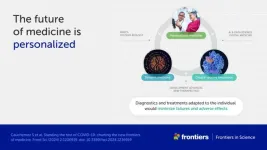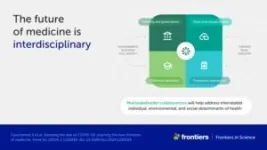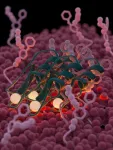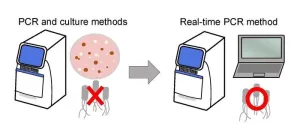(Press-News.org) What should the medicine of the future look like? A team of scientists writing in Frontiers in Science lays out a bold vision for precision approaches to understanding, preventing, and treating diseases, driven by revolutionary technologies and new interdisciplinary collaborations between researchers and other health sector professionals. The internationally renowned authors – led by Prof Michel Goldman, recipient of the Blaise Pascal Medal 2024 for his exceptional contributions to immunology and healthcare innovation, and leading microbiologist Prof Philippe Sansonetti from the Institut Pasteur and Collège de France – build on the many lessons of Covid-19, from strategies for radically faster vaccine development to use of big data and digital medicine.
“The Covid-19 pandemic will have profound, long-lasting impacts on the anticipation of risk, practice of medicine, and the management of healthcare,” said Goldman, who is President and founder of the Institute for Interdisciplinary Innovation in Healthcare (I3H) at the Université Libre de Bruxelles and former Executive Director of the Innovative Medicines Initiative (IMI).“It demonstrated the importance of collaboration across sectors and disciplines to develop new solutions for major public health threats, and the power of artificial intelligence and digital tools for the advancement of medicine.”
Changing the paradigm
To overcome Covid-19, the world needed to take a radically different approach to care – and scientists innovated to make this happen. 9% more health-related articles were published worldwide than expected in 2020-22, reflecting scientists’ search for tools to solve the problems of the pandemic, which ultimately went far beyond the treatment of infectious diseases. Because there were initially no vaccines to control transmission, we needed non-pharmaceutical interventions like lockdowns, planned using large-scale mathematical modeling. Videocalls ensured patients could speak to a doctor without risking catching the virus, while insights from big data were used to identify vulnerable patients and target treatments. Goldman and his colleagues say that these are innovations in medicine – personalized, taking advantage of big data and new technology – that we should use to design the future of healthcare and public health.
“Personalized medicine delivers the right treatment to the right patient at the right time,” said Sansonetti. “It will depend on in-depth characterization of both the genetic make-up of the affected individual and the molecular mechanisms of the disease. A patient’s way of life and environment will also be taken into consideration.”
Systems medicine could also enable more effective care: it “exploits large quantities of different kinds of data, gathered through different sources, to generate highly precise diagnosis, prognosis, and therapeutic options,” explained Sansonetti. For instance, it could help identify pre-existing drugs which we already know are safe that can be quickly repurposed to treat new diseases.
Meanwhile, digital health can take medicine to the individual. Telehealth can make it easier for patients to consult with a medical professional, while wearable monitors allow for at-home management of some conditions, which is associated with better outcomes.
A roadmap for healthcare
However, the scientists stress that a lot of work needs to be done to make this vision a reality. The necessary conditions for this medicine of the future are not equally available worldwide: for instance, in some places, the technology for digital health or the tests necessary for personalized medicine are less available. For systems medicine to work effectively and safely, AI applications need to be more transparent, and must be carefully managed to ensure patient privacy and avoid bias.
We also urgently need to implement a framework for funding and research which supports the kind of interdisciplinary work that drove innovation during the pandemic: Goldman and colleagues lay out what this could look like, and what we need to tackle first. The greatest likely challenges of the future, antimicrobial resistance and zoonotic illnesses that jump from animals to humans, will need to be addressed by scientists and clinicians from many disciplines working together. We need to enable this cooperation now, by encouraging interdisciplinary studies and collaboration, to build healthcare that can overcome these future challenges.
“As we navigate the complexities of the post-Covid era, we must foster multidisciplinary collaborations that transcend traditional boundaries, encompassing molecular, clinical, and social determinants of health,” concluded Dr Giuseppe Remuzzi, director of the Istituto di Ricerche Farmacologiche Mario Negri and senior author of an editorial commentary on the article. “This very timely article is a statement of intent – a testament to the resilience and adaptability of science to address forthcoming public health challenges.”
END
Big data, AI, and personalized medicine: scientists reveal playbook aiming to revolutionize healthcare
The Covid-19 pandemic changed medicine forever – now scientists reveal a bold new vision for the healthcare of the future
2024-05-23
ELSE PRESS RELEASES FROM THIS DATE:
First ever survey of A&E triage nurses highlights problems with a lack of training, low staffing, high stress and overflowing departments
2024-05-23
Peer-reviewed - survey - people
Nurses who assess patients at emergency departments would like more training and say their decisions can be negatively impacted by the high pressures of their work.
Researchers at the University of East Anglia conducted the first ever UK survey of triage nurses to discover the background, training and decision-making processes of this role in emergency departments.
Lead author Hugh Gorick, a PhD researcher at UEA’s School of Health Sciences who also works as an assistant practitioner in an NHS hospital’s Acute Medical Unit, said: “More than 24 million patients present to emergency departments ...
The global clean water crisis looms large
2024-05-23
Water scarcity will intensify with climate and socioeconomic change, disproportionately impacting populations located in the Global South. So concludes a new Utrecht University article published in Nature Climate Change on 23 May 2024, which used a state-of-the-art global water quantity and quality model to estimate clean water scarcity until the end of the century.
Humans require clean water for drinking and sanitation purposes, but also for the production of food, energy and manufactured goods. As communities and policymakers grapple with water scarcity issues on the ground, researchers ...
Antibiotic ‘Velcro’ gives bacteria a sticky situation
2024-05-23
A small antibiotic called plectasin uses an innovative mechanism to kill bacteria. By assembling into large structures, plectasin latches onto its target on the bacterial cell surface comparable to how both sides of Velcro form a bond. A research team, led by structural biologist Markus Weingarth and biochemist Eefjan Breukink at Utrecht University, mapped how the Velcro-structure is formed. Their discovery, published in the scientific journal Nature Microbiology, unveils a new approach that could have broad implications for the development of antibiotics to ...
City of Hope researchers to present investigational treatments for colorectal, kidney and blood cancers at 2024 American Society of Clinical Oncology (ASCO) Annual Meeting
2024-05-23
LOS ANGELES — World-renowned physicians and researchers from City of Hope®, one of the largest cancer research and treatment organizations in the United States, will present new data and offer expert perspectives on leading-edge cancer research and treatments in development at the 2024 ASCO Annual Meeting, which will take place in Chicago from May 31 to June 4. Highlights include the following:
2024 Best of ASCO® program: New data on mismatched unrelated donor peripheral blood stem cell transplantation
Late-breaking data on the phase 3 CodeBreaK 300 trial
Glofitamab monotherapy for patients ...
Bigger is better: male proboscis monkeys’ enhanced noses evolved to attract mates
2024-05-23
When it comes to the animal kingdom, bigger is better. Well, at least for proboscis monkeys, famously known for their long, large and droopy noses.
Researchers from The Australian National University (ANU) have provided a world-first explanation for why male proboscis monkeys have larger and “enhanced” nasal structures.
The researchers examined the bony nasal cavity inside the skulls of proboscis monkeys and found their large noses are more than just an eye sore and in fact offer several major benefits, especially when ...
Early access to first-seizure clinics, subsequent outcomes, and factors associated with attendance
2024-05-23
About The Study: The results of this cohort study suggest that first-seizure clinic (FSC) attendance, particularly early attendance, was associated with reduced rates of subsequent hospital utilization. This knowledge may support adequately resourcing FSCs to improve equitable, timely access. Future study directions include assessing interventions that may support FSC attendance for at-risk groups.
Corresponding Author: To contact the corresponding author, Emma Foster, M.B.B.S.(Hons), Ph.D., email emma.foster@monash.edu.
To access the embargoed study: Visit our For The Media website at this link https://media.jamanetwork.com/
(doi:10.1001/jamaneurol.2024.1187)
Editor’s ...
How stores use TikTok to sell e-cigarettes to children
2024-05-23
A new paper in Nicotine and Tobacco Research, published by Oxford University Press, shows that advertising and sales of vaping products is common on TikTok, the video sharing platform popular among teenagers. Users pushing these items often use hashtags like #puffbundles to disguise vaping products by including things like lip gloss and candy in the packages for sale.
Despite smoking rates reaching an all-time low in the United States, public health professionals are concerned about adolescent use of electronic cigarettes. In 2023 some 4.7 million (17%) middle school and high school students ...
Mistaken identity cleared up of foodborne pathogen causing severe symptoms in children
2024-05-23
The prevalence of pathogenic E. coli has meant the frequent misidentification of a similar bacterium of the Escherichia genus. E. albertii is an emerging zoonotic foodborne pathogen, first isolated in Bangladesh in 1991. Large-scale outbreaks of food poisoning caused by E. albertii have since been reported especially in Japan, causing severe symptoms in both children and adults.
In the hopes of establishing a diagnostic method, a joint research group led by Professor Shinji Yamasaki and Dr. Sharda Prasad Awasthi, a specially appointed ...
Approximately one in nine U.S. children diagnosed with ADHD, as new national study highlights an “ever-expanding” public health concern
2024-05-23
An exploration into the national U.S. dataset on children ever diagnosed with ADHD has revealed an “ongoing and ever-expanding” public health issue.
Findings published in the peer-reviewed Journal of Clinical Child & Adolescent Psychology uncover that approximately one million more children, aged 3-17, had received an ADHD diagnosis in 2022 than in 2016.
The paper reveals around one in nine children have ever received an ADHD diagnosis – 11.4%, ...
Survey: Parents of young athletes value health benefits of sports, but experts emphasize watching for signs of stress, burnout
2024-05-23
COLUMBUS, Ohio (May 23, 2024) — Positive sports experiences can be a game changer for kids, with physical, social, emotional and mental health benefits that last a lifetime, according to a new survey from The Kids Mental Health Foundation. However, youth mental health advocates with The Kids Mental Health Foundation stress the importance of ongoing conversations with young athletes about how their sports are impacting their confidence, self-esteem and happiness, whether it’s positive or negative.
The national survey conducted by Ipsos on behalf of The Kids Mental Health Foundation finds parents overwhelmingly ...
LAST 30 PRESS RELEASES:
House sparrows in northern Norway can help us save other endangered animals
Crohn's & Colitis Foundation survey reveals more than 1/3 of young adults with IBD face step therapy insurance barriers
Tethered UAV autonomous knotting on environmental structures for transport
Decentralized social media platforms unlock authentic consumer feedback
American Pediatric Society announces Vanderbilt University School of Medicine as host institution for APS Howland Visiting Professor Program
Scientists discover first method to safely back up quantum information
A role for orange pigments in birds and human redheads
Pathways to net-zero greenhouse gas emissions for Southeast Asia
A JBNU–KIMS collaborative study on a cost-effective alloy matches superalloys for power plants and energy infrastructure
New study overturns long-held model of how plants coordinate immune responses.
New AI model predicts disease risk while you sleep
Scientists discover molecular ‘reshuffle’ and crack an 80-year-old conundrum
How stressors during pregnancy impact the developing fetal brain
Electrons lag behind the nucleus
From fungi to brain cells: one scientist's winding path reveals how epigenomics shapes neural destiny
Schizophrenia and osteoporosis share 195 genetic loci, highlighting unexpected biological bridges between brain and bone
Schizophrenia-linked genetic variant renders key brain receptor completely unresponsive to both natural and therapeutic compounds
Innovative review reveals overlooked complexity in cellular energy sensor's dual roles in Alzheimer's disease
Autism research reframed: Why heterogeneity is the data, not the noise
Brazil's genetic treasure trove: supercentenarians reveal secrets of extreme human longevity
The (metabolic) cost of life
CFRI special issue call for papers: New Frontiers in Sustainable Finance
HKU Engineering scholar demonstrates the smallest all-printed infrared photodetectors to date
Precision empowerment for brain "eavesdropping": CAS team develops triple-electrode integrated functional electrode for simultaneous monitoring of neural signals and chemical transmitters during sleep
Single-capillary endothelial dysfunction resolved by optoacoustic mesoscopy
HKU three research projects named among ‘Top 10 Innovation & Technology News in Hong Kong 2025’ showcasing excellence in research and technology transfer
NLRSeek: A reannotation-based pipeline for mining missing NLR genes in sequenced genomes
A strand and whole genome duplication–aware collinear gene identification tool
Light storage in light cages: A revolutionary approach to on-chip quantum memories
Point spread function decoupling in computational fluorescence microscopy
[Press-News.org] Big data, AI, and personalized medicine: scientists reveal playbook aiming to revolutionize healthcareThe Covid-19 pandemic changed medicine forever – now scientists reveal a bold new vision for the healthcare of the future






